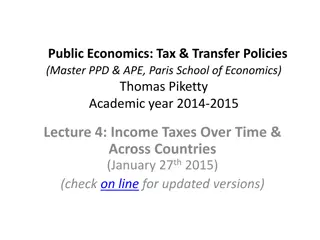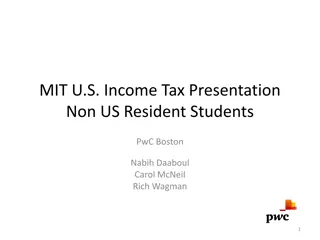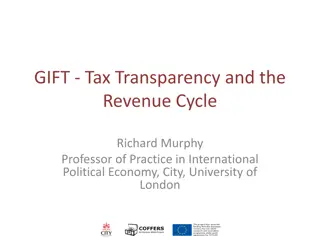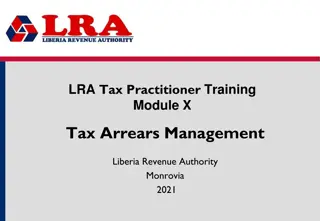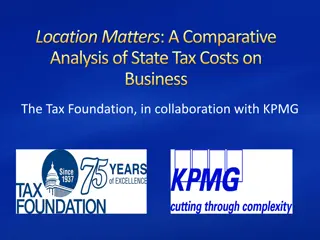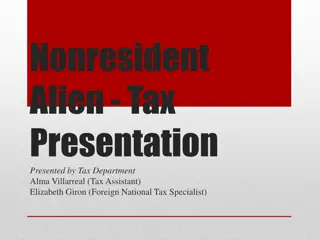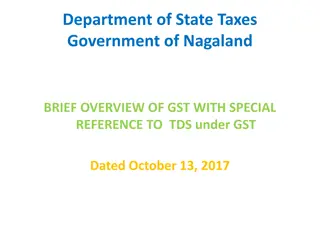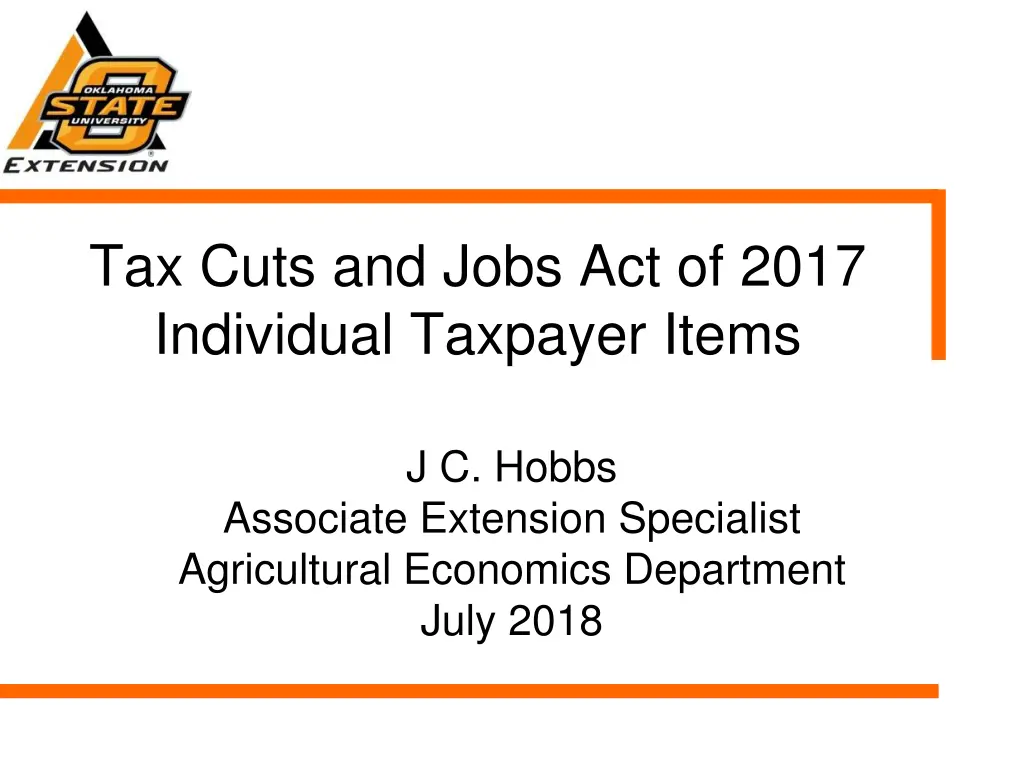
Tax Cuts and Jobs Act 2017 Summary
Learn about the Tax Cuts and Jobs Act of 2017, its impact on individual taxpayers, changes in tax rates, standard deductions, and more. Explore the differences in tax laws, rates, and deductions before and after the act came into effect. Stay informed and understand the evolving taxation landscape for both individuals and businesses.
Download Presentation

Please find below an Image/Link to download the presentation.
The content on the website is provided AS IS for your information and personal use only. It may not be sold, licensed, or shared on other websites without obtaining consent from the author. If you encounter any issues during the download, it is possible that the publisher has removed the file from their server.
You are allowed to download the files provided on this website for personal or commercial use, subject to the condition that they are used lawfully. All files are the property of their respective owners.
The content on the website is provided AS IS for your information and personal use only. It may not be sold, licensed, or shared on other websites without obtaining consent from the author.
E N D
Presentation Transcript
Tax Cuts and Jobs Act of 2017 Individual Taxpayer Items J C. Hobbs Associate Extension Specialist Agricultural Economics Department July 2018
HMMMM.. The difference between death and taxes is death doesn t get worse every time Congress meets. -- Will Rogers
Tax Cuts and Jobs Act December 22, 2017, President Trump signed H.R. 1, the Tax Cuts and Jobs Act into law which now changes the taxation landscape for both individuals and businesses. Purpose: Reduce taxes but broaden the tax base to increase overall revenues Topics: Individual taxpayer changes
Individual Changes Tax rates have changed: 2017: 10%, 15%, 25%, 28%, 33%, 35%, and 39.6% 2018: 10%, 12%, 22%, 24%, 32%, 35%, and 37% Rate changes are effective for tax years beginning after December 31, 2017 and before January 1, 2026 Legislation is being introduced to make changes permanent
Tax Rate Comparison for Single Taxpayers Old Law Break Point >$0 >$9,325 >$37,950 >$91,900 >$191,650 >$416,700 TCJA Rate 10% 15% 25% 28% 33% 35% 39.6% >$418,400 Rate Break Point 10% >$0 12% >$9,525 22% >$38,700 24% >$82,500 32% >$157,500 35% >$200,000 37% >$500,000
Tax Rate Comparison for Married Filing Joint Old Law Break Point >$0 >$19,050 >$77,400 >$156,150 >$237,950 >$424,950 TCJA Rate 10% 15% 25% 28% 33% 35% 39.6% >$480,050 Rate Break Point 10% >$0 12% >$19,050 22% >$77,400 24% >$165,000 32% >$315,000 35% >$400,000 37% >$600,000
Standard Deduction Standard Deduction increased for tax years beginning after December 31, 2017 and before January 1, 2026 Single = $12,000 Married Filing Joint = $24,000 Head-of-Household = $18,000 Married Filing Separate = $12,000 No change to additional deduction amount for elderly or blind ($1,300 or $1,600 dependent upon filing status)
Standard Deduction If Adjusted Gross Income is $12,000 or less, then a single individual pays no tax in 2018 (the zero percent bracket) or If Adjusted Gross Income is $24,000 or less, then a married filing joint couple pays no tax in 2018 (the zero percent bracket) Amount is indexed for inflation annually
Personal Exemptions Personal Exemptions are SUSPENDED For tax years beginning after December 31, 2017 and before January 1, 2026. Reduces the exemption amount to zero. 2017 was $4,050 per exemption 2018 was to be $4,150 per exemption, but the TCJA zeroed it
Better off Tax wise? Married Couple Filing Joint (no dependents) Old Law Adj Gross Inc 100,000 Std Deduction 13,000 Exemption Taxable Income 78,700 Tax Due 10,983 TCJA 100,000 24,000 8,300 0 76,000 8,739
Child Tax Credit New law increases to $2,000 from $1,000 for each qualifying child under 17 years of age. AGI phase outs apply but now $400,000 MFJ Refundable amount increased to $1,400 per qualifying child SSN required for each child Non-child dependent was added under the new law for an amount of $500.
Better off Tax wise? Married Couple Filing Joint w/2 children Old Law 100,000 13,000 16,600 70,400 9,608 2,000 7,747 TCJA 100,000 24,000 Adj Gross Inc Std Deduction Exemption Taxable Income Tax before Credit Child Tax Credit Tax Due 0 76,000 8,739 4,000 4,739
Better off Tax wise? You will not know the exact answer to your specific tax situation until you file your 2018 income tax return. Visit with you tax advisor before December 2018 to avoid any disasters. (such as under payment penalties) The devil is truly in the details.
Kiddie Tax Child <19 or full-time student <24 years old Unearned vs Earned Income Beginning for tax years after Dec. 31, 2017 earned income is taxed at single individual rates Taxable income from unearned sources (if >$2,100 from portfolio, capital gains, etc.) are taxed using the estate and trust income tax brackets. Estates and Trusts: 10%, 24%, 35% and 37%
Kiddie Tax If Taxable Income Is: The Tax Is: > $0 but $2,550 > $2,550 but $9,150 > $9,150 but $12,500 > $12,500 and over 10% of the taxable income $225 + 24% of excess > $2,550 $1,839 + 35% of excess > $9,150 $3,011.50 + 37% of excess > $12,500 17
Itemized Deductions Many itemized deductions were suspended With Standard Deduction at $24,000 MFJ ($12,000 Single) the tax relief from itemizing is greatly reduced Typically, itemizing has value when the total itemized deductions exceeds the taxpayer s standard deduction amount
Itemized Deductions Itemized Deduction Changes for tax years beginning after December 31, 2017 and before January 1, 2026: A Taxpayer may deduct State, Local and foreign property taxes, and State and local income taxes to a cap of $10,000 (MFJ) or $5,000 (MFS) Home Mortgage Interest and Home Equity Mortgage Interest is allowed subject to indebtedness limitations $750,000 ($375,000 Married Filing Separate)
Itemized Deductions Itemized Deduction Changes (cont.) Unreimbursed employee expenses (travel, meals, uniform, job search, etc.) Tax preparation expenses Investment fees and expenses Safe deposit box rental Hobby expenses Moving expenses unless a member of the military
Personal Property Losses Personal Casualty and Theft Losses For tax years beginning after December 31, 2017 and before January 1, 2026 Are suspended, except for personal casualty losses incurred in a Federally-declared disaster area.
Charitable Contributions Charitable Contribution Deduction Limitation Increased Beginning for tax years after December 31, 2017 and before January 1, 2026, the contribution limit is increased to 60% from 50% Example: AGI = $100,000, limit is now $60,000, the $40,000 excess contribution can be carried forward five years.
Avoid Under Withholding Penalty May need to adjust the number of withholding allowances on Form W-4 If you had a large amount of itemized deductions in 2017 Household income is $200,000 or more (be safe: check if income is > $150,000) Talk to your taxpreparer soon!!!
Avoiding the Penalty Must withhold at these levels: 1. 90% of current years tax due 2. 100% of 2017 tax paid or 110% of 2017 tax paid for high income (AGI > $150,000) 2018 withholding calculator https://apps.irs.gov/app/withholdingcalculator/
Questions? Be sure to visit your taxpreparer to avoid a surprise when it is time to file for 2018 Thank you for your attention!! J C. Hobbs Associate Extension Specialist Email: jc.hobbs@okstate.edu


![Town of [Town Name] Real Estate Tax Rates and FY 2024 Budget Summary](/thumb/62211/town-of-town-name-real-estate-tax-rates-and-fy-2024-budget-summary.jpg)





